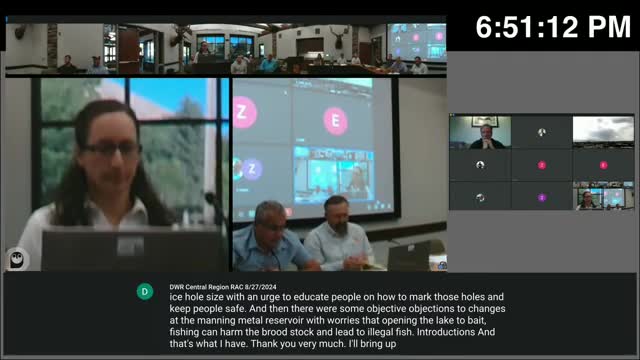Safety Concerns Spark Debate Over Ice Hole Regulations
August 28, 2024 | Utah Office of Tourism, Utah Governor's Office of Economic Opportunity, Offices, Departments, and Divisions, Organizations, Utah Executive Branch, Utah
This article was created by AI summarizing key points discussed. AI makes mistakes, so for full details and context, please refer to the video of the full meeting. Please report any errors so we can fix them. Report an error »

During a recent government meeting, significant discussions centered around fishing regulations and safety concerns related to ice fishing in Utah. Public comments were made by representatives from various organizations, highlighting the need for careful consideration of proposed changes.
Ken Strong, a sportsman advocating for fish and wildlife, expressed concerns about the proposed increase in the size of ice holes allowed for fishing. He argued that larger holes could pose safety risks, particularly on the south end of the lake, where ice conditions are less stable. Strong emphasized that Utah should maintain its current regulations rather than conform to Wyoming's standards, which he believes could compromise safety for anglers, especially children.
Additionally, Strong proposed a new regulation aimed at combating illegal fish planting. He suggested implementing a \"catch and kill\" policy for any illegally introduced fish, with the stipulation that these fish cannot be taken home by anglers. This measure, he argued, would help protect local fisheries from the detrimental effects of unauthorized fish species.
Peter Jimberg, representing the Utah chapter of Backcountry Hunters and Anglers, supported the proposed regulation changes, asserting they would enhance fishing opportunities for local anglers.
The discussion then shifted to the specifics of the ice hole size regulations. Some members expressed skepticism about the necessity of increasing the size limit, citing personal experiences with ice safety. Concerns were raised about the potential for accidents, particularly in areas where ice does not freeze uniformly.
After deliberation, a motion was made to maintain the current 18-inch limit on ice holes, which was unanimously approved by the committee. This decision reflects a commitment to prioritizing safety over increased fishing convenience.
The meeting also touched on the management of broodstock lakes, with officials clarifying that while fish are not removed from these waters, eggs are harvested for hatchery purposes. This practice aims to sustain fish populations while allowing for regulated fishing opportunities.
Overall, the meeting underscored the importance of balancing fishing regulations with public safety and ecological integrity, with decisions set to be reviewed in two years.
Ken Strong, a sportsman advocating for fish and wildlife, expressed concerns about the proposed increase in the size of ice holes allowed for fishing. He argued that larger holes could pose safety risks, particularly on the south end of the lake, where ice conditions are less stable. Strong emphasized that Utah should maintain its current regulations rather than conform to Wyoming's standards, which he believes could compromise safety for anglers, especially children.
Additionally, Strong proposed a new regulation aimed at combating illegal fish planting. He suggested implementing a \"catch and kill\" policy for any illegally introduced fish, with the stipulation that these fish cannot be taken home by anglers. This measure, he argued, would help protect local fisheries from the detrimental effects of unauthorized fish species.
Peter Jimberg, representing the Utah chapter of Backcountry Hunters and Anglers, supported the proposed regulation changes, asserting they would enhance fishing opportunities for local anglers.
The discussion then shifted to the specifics of the ice hole size regulations. Some members expressed skepticism about the necessity of increasing the size limit, citing personal experiences with ice safety. Concerns were raised about the potential for accidents, particularly in areas where ice does not freeze uniformly.
After deliberation, a motion was made to maintain the current 18-inch limit on ice holes, which was unanimously approved by the committee. This decision reflects a commitment to prioritizing safety over increased fishing convenience.
The meeting also touched on the management of broodstock lakes, with officials clarifying that while fish are not removed from these waters, eggs are harvested for hatchery purposes. This practice aims to sustain fish populations while allowing for regulated fishing opportunities.
Overall, the meeting underscored the importance of balancing fishing regulations with public safety and ecological integrity, with decisions set to be reviewed in two years.
View full meeting
This article is based on a recent meeting—watch the full video and explore the complete transcript for deeper insights into the discussion.
View full meeting

